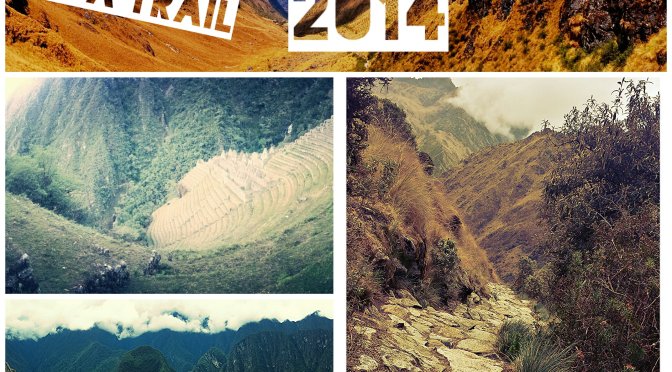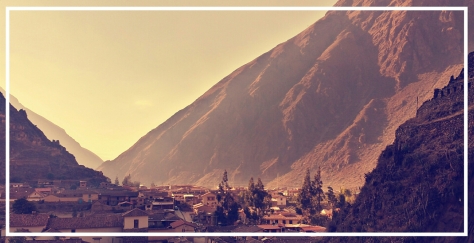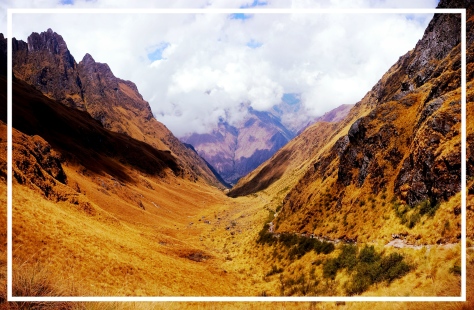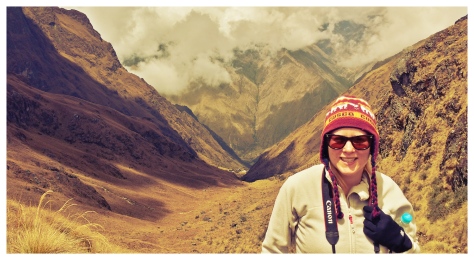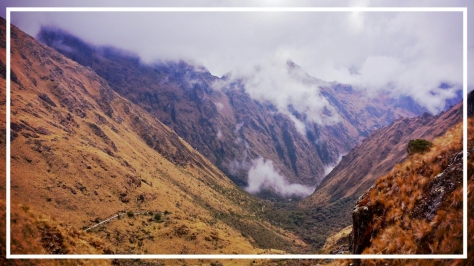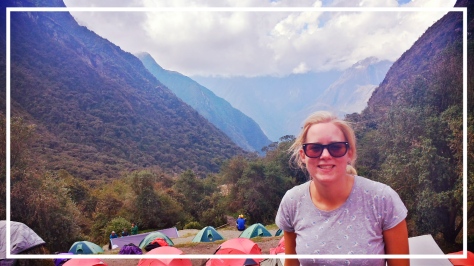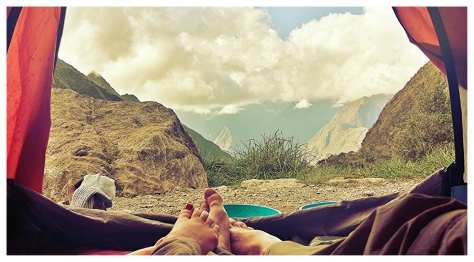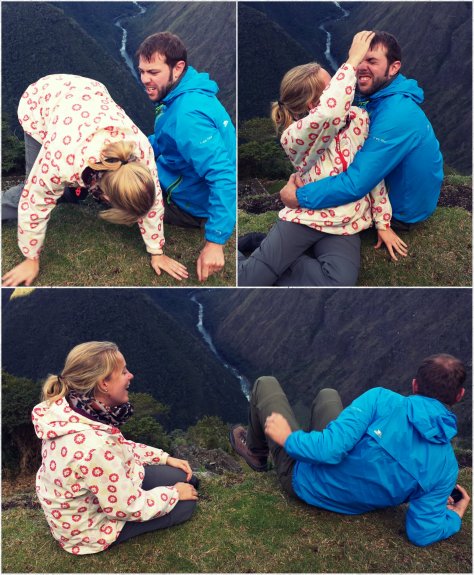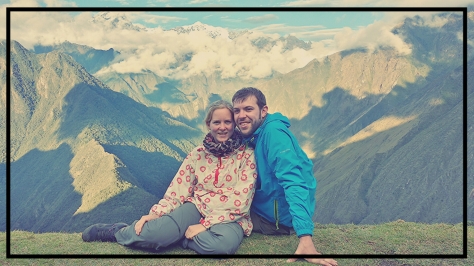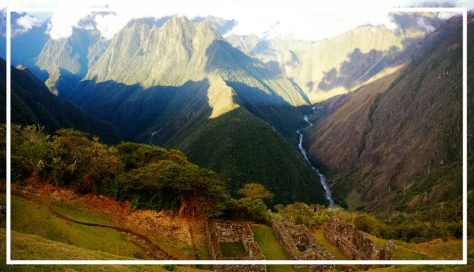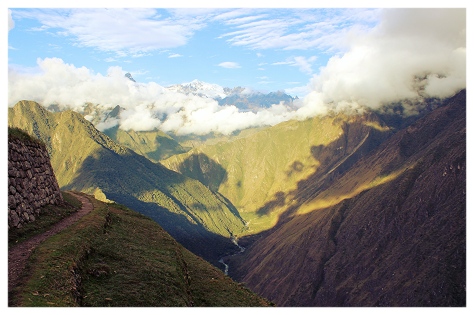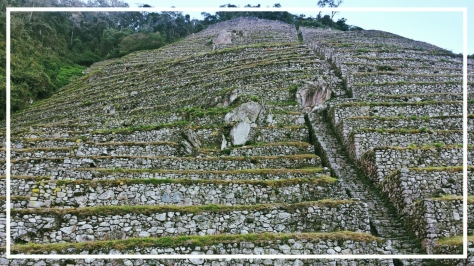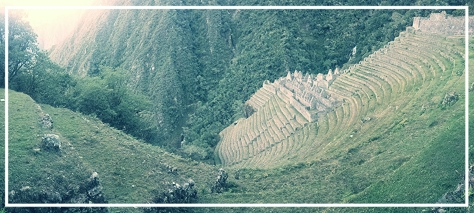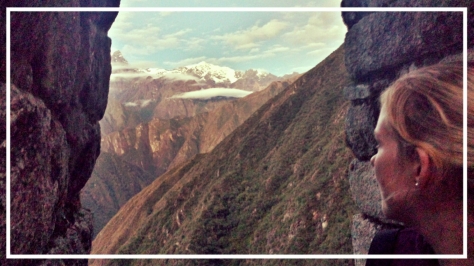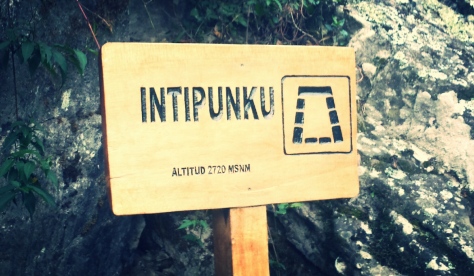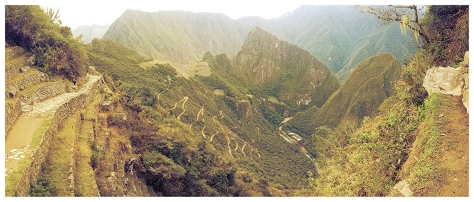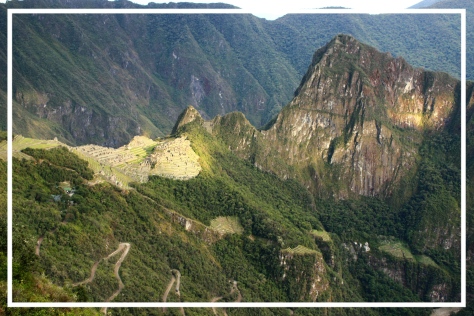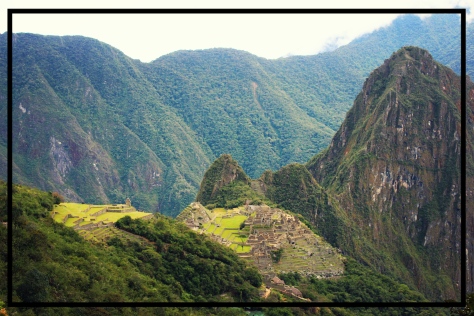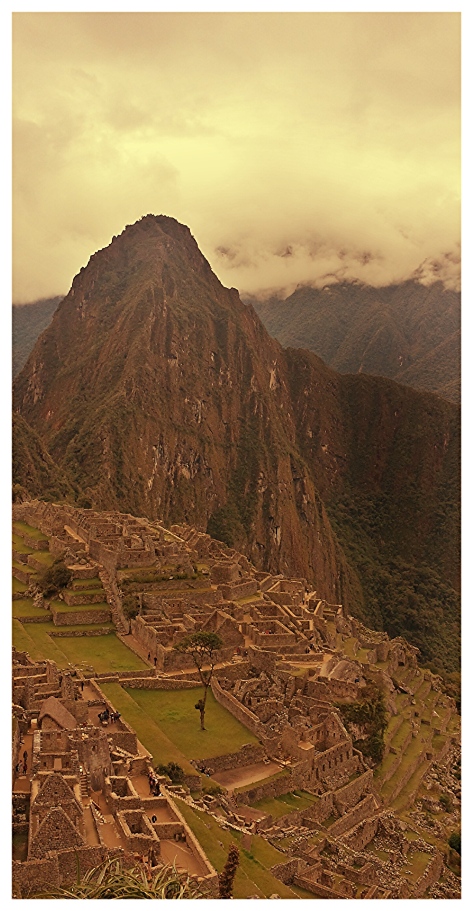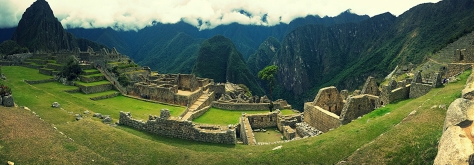The pinnacle of the South America leg of the Olleydays’ tour. Without a doubt. It was bound to be. The Inca trail is highly regarded as one of the most incredible treks on the globe and UNESCO deem it special enough to have amongst their armoury of spectacular and preservation worthy locations.
The anticipation had been great and the day had finally arrived. The journey of 42km, across 4 days of trekking, to reach our ultimate destination of Machu Picchu was upon us. The bulk of our Inca family, fortunately, had been initiated prior to the start of the trail with the lion’s share of us already friends from the, still in progress, G Adventures tour. The family consisted of: Michelle, myself and Sophie, making up the English contingent; ‘Norway’, as they were affectionately and collectively referred to as, was made up of Henriette and Christian, from Norway; our resident events and activities guru Romanian Elena and Jill, our baby of the group from the US.
We decided, having missed the Temple of the Sun the previous day, before the main course of El Camino Inca, that we’d head out at dawn to cram in the temple as a starter. Aptly, the sun beat down on us as we climbed the steps to get a good view across the town of Ollantaytambo.
It was certainly worth the effort, despite the impending and daunting prospect of chasing it up with the start of the Inca Trail.
The intense lack of oxygen in the air served as a sobering reminder of the journey we were about to embark on. If we were struggling for breath climbing a few stone steps, the altitude and distances we were due to cover over the next few days were going to perhaps come as a shock. Were we all going to manage this? I reminded myself that I went swimming at least 3 times before we embarked on this trip, so my stamina should be fine for such extremes. We put the lack of stamina and shortage of breath down to the fact we hadn’t eaten yet with each and every member of the Inca family knowing deep down that this was a way of suppressing the worry of whether or not we’d actually survive what was to come. Id be lying if I said I wasn’t a little apprehensive…
The Inca trail officially began amongst a blaze of optimism and enthusiasm and with two new additions, Rafa and Innes from Switzerland.
Caution to the metaphorical wind was taken to not traipse off at a such a pace that was not likely to be maintained over the coming days. Despite this being widely confirmed as the most gentle of days, there were moments, later in the day, where motivation would wane only momentarily. Our newly formed Inca family was on hand to provide some well directed banter, encouragement or coca leaves to refocus our energies.
The Inca family was not alone on this trek, in fact, we were the minority. Each day 250 permitted travellers take to the Inca trail under the strict guidance of at least 2 resident experts, the brains. Our experts were Enrique and Clissa. These guys were on hand to teach us about the ancient civilisation of the Inca’s and their various sites of interest that we would be visiting en route to Machu Picchu and to physically guide us across the Andes.
As this trail was to take 4 days, we were accompanied by 18 of the most incredible men I’ve ever met. The porters are the brawn behind the trail and transport tents, luggage, cooking equipment, gas, food and drink along the entire route making it possible for novices like us to enjoy the trail. These incredibly fit, forgiving, patient and humble men are the only reason that the trail is accessible to people like me. They start the journey after the trekkers and overtake on the way, carrying mounds of luggage on their backs, to ensure tents are erected and food is on the table for the trekkers when they arrive at camp. One of the porters within our family had recently completed the entire Inca trail, in a staggering 3 and a half hours! It was due to take us 4 days. That knowledge should have been enough of an embarrassment for us to sprint to our campsite for the remaining few km, but the distraction of the rain that had started and discussions of what we thought we might be eating for dinner that evening meant that we arrived where we would be camping for the first night sooner than we’d anticipated.
Dinner was incredible. Whether it was the intense exertion of energy and extreme hunger that made everything taste better, or the frequent ‘go-to’ reason for every event, ‘the altitude’, was unclear. What was clear was that our chefs excelled themselves each day, never repeating a meal. Each lunch and dinner consisted of a different soup, followed by main courses of various meats, fish, vegetables, rice, chips, quinoa (the ‘supergrain’ of the future) and even homemade pizzas and, incredibly, a cake on the final day! After our first meal, and over our digestion enhancing coca tea, conversation turned to the trying times that we would face tomorrow. We all knew the tales of ‘the second day’ where people turn back because they can’t complete it or become incredibly ill as a result of the altitudes and intense periods of uphill trekking involved. At the day’s summit, the Dead Woman’s pass, we would then spend the rest of the day descending.
It felt like we’d never arrive. Whilst the warm weather and clear sky skies made everything incredibly beautiful, it meant that perspiration was rife and made things just a little more uncomfortable. The air thinned further, along with our motivation, and as the legends informed, people were turning back, defeated. Rest stops became more frequent and our group got spread out along the trail to allow individuals to go at a pace that suited them.
Dead Woman’s pass got slowly nearer. Catching sight of Norway already at the summit and their cheers of encouragement gave us the final energy sapping boost to reach the top. Blistered and in some pain, we turned to survey from whence we came:
Time for photos to prove we completed half of day two.
After a 10 minute rest, it was time to set off down the other side, but not before a quick survey of the route below.
Unlike my slow, cumbersome and particularly ungracious ascents, I found the downhill sections a lot easier than the flat and uphill sections at the start, preemptively locating safe locations for each foot and using momentum to skip down the Andes at a decent pace. Michelle found it particularly difficult however, on account of a ‘jippy knee’. As time wore on, the tiredness set in and I wasn’t making such good decisions and I frequently lost my footing and pace. The blisters worsened, the energy deteriorated and again, the motivation drained, to the extent that I questioned the decision to do the Inca Trail at all.
All this vanished at camp number 2. It was the most beautiful place I’ve ever seen.
Just the sight of our tents ready and erect in the distance refueled our bodies and minds, but coupled with the calmness, grandeur and serenity of the Andean surroundings, was just once-in-a-lifetime stuff. The way they sat, in a channel, flanked and dwarfed by the monstrous mountains was a sight never to forget.
The porters brought round hot water to each tent to let us wash our tired feet. Removing my boots and socks and soaking in that water was an unrivalled experience, but one I felt I’d earnt. Soothing my feet and taking in the surroundings was definitely the reward for a hard day’s trekking. I challenge someone to show me a more impressive view from a tent…
Day three started; a refreshed and rejuvenated family. The pancakes for breakfast may have had something to do with it. Optimism was oozing from the campsite, safe in the knowledge that the hardest day was over. Day three was to be the longest day, in both distance and duration, with a plethora of interesting Incan sites to visit along the through the cloud forest.
After a few minutes into the third day, true to the name, the clouds closed in. Visibility was poor and we were left to imagine the views that surrounded us as we trekked. The rain was the annoyingly fine and persistent mist that seems to instantly saturate everything within 7 seconds of exposure, despite the illusion that it appears to not be raining, at all. The lack of decent views meant that there was more time to discuss Incas with our guides.
It turns out that the Incan culture is only around 500 years old. The marvel is that they were only ‘discovered’ about 100 years ago by a Hawaiian scholar, Hiram Bingham. For some reason, I had absolutely no idea of this and had assumed, and was somewhat disappointed, that they existed thousands of years ago. The reason for the inverted commas discovered is that academia and western cultures discovered them via Bingham. The indigenous had known about them for some indeterminable amount of time before this, they were well aware. They’d had no contact with westerners and really had no reason to let them know about their sacred sites. All of the sites that we visited along the way had some unique function as to why they were situated where they were. They were either agricultural sites bearing the trademark terrace structure; religious sites where shrines and other evidence of offerings were found or outposts and checkpoints that the Incas would use to protect themselves.
It was also a chance for us to learn a bit of Quechua too. From what I remember about Quechua (we briefly touched upon it in my linguistics degree at Lancaster), its an agglutinating language, a language that joins together the grammatic and lexical content that we separate in english with spaces between words. So each ‘sentence’ in Quechua is really only one long word. What was interesting was understanding that there is no translation for ‘goodbye’. The Quechua speakers consider this to be too final and the closest translation is something like ‘see you in the other world’ Tupananchiskama.
The rain continued well into the afternoon and we wondered if the weather was set for a few days meaning our visit to Machu Picchu would be shrouded in mystery and pea soup (Incidently, Machu Picchu is Quechuan too, meaning ‘Old Mountain’, and is the mountain that the temple sits on). As we neared the final campsite, the clouds started to part, drawing the curtains on quite possibly the most incredible view I have ever witnessed. We spent alot of time here just taking in the majesty of the scenery, particularly as all we’d really seen all day was just grey. Intipata, or ‘sun place’ provided the perfect opportunity for the obligatory photos and Michelle spent ages trying to prepare me for the photo.
We eventually managed to get a decentish shot of me, something of a rarity.
The images taken really don’t do the scenery or the feeling of achieving that we all experienced in this wonderful few minutes.
The view was so mesmerizing that we’d almost forgotten to look behind us back at Intipata. The view was afforded to us from a huge Incan Terrace.
The view would probably have been slightly enhanced from a short ramble to the top, but the fact we could even see our campsite for the final sleep in the depths of the valley encouraged us to make our way there, plus the promise of our guide’s favourite Incan site. Enrique, or Kike as we were allowed to call him now, advised that we needed to be quick to see it before dusk.
We marched into camp to raucous applause and high fives from our porters. We dumped our gear and headed out of camp straight to Wiñaywayna, translated, ‘Forever Young’. Wiñaywayna sits nestled amongst a steep valley and drifts around the natural contours, looking out into the Andes. As the light started to fail, the place assumed a very calming and magic quality. As the other trekkers headed back to camp, we were left on our own to soak up Wiñaywayna, all to ourselves.
An early night was needed as we needed to leave camp at about 3 30am to ensure we reached the world renowned Sungate, or Intipunku (my expert linguistic deduction skills working out that ‘Inti’ meant ‘Sun’ and ‘Punku’ meant ‘gate’, although the literal translation in ‘door’) at sunrise.
Excitement and anticipation of reaching Machu Picchu was tangible that morning and was probably the sole driving force behind us actually surfacing at that hour. We got our penultimate stamp in our passport and headed off up to Intipunku at quite a pace. The final approach to the Sungate is incredibly steep and is the final testing time before you catch your first glimpse of the object of your last 3 days of hiking.
We could almost sense the feeling of the people ahead of us as they scrambled over the mountain and set their eyes upon Machu Picchu. We’d arrived.
The emotions and tiredness were overwhelming and we’d all made it. It was somewhat cloudy but as the sun came up, a beam of light shone directly onto the temple illuminating and signposting the way for the final descent into the temple itself.
The tour was even more special as our guides stayed with us as we walked around the site giving us more useful and interesting info; stopping only to scoff at the scores of people daytripping and taking the bus up to visit. We had a sense of pride that we’d achieved and earnt the right to be there enjoying the sacred site, albeit with a bit of help!
The famous mountain that often accompanies shots of Machu Picchu (even though the mountain of Machu Picchu is rarely in the shots) is called ‘Wayna Picchu’, which again, my powerful linguistic deduction skills told me was ‘Young Mountain’. There was an option to climb this mountain, but only via prebooking.
Time to enjoy the fruits of our labour.
Michelle and I had some time to ourselves and found a nice quiet spot in front of the main attraction on part of the agricultural site, the terraces. The time was spent admiring the view and contemplating our journey of Andean Discovery.

